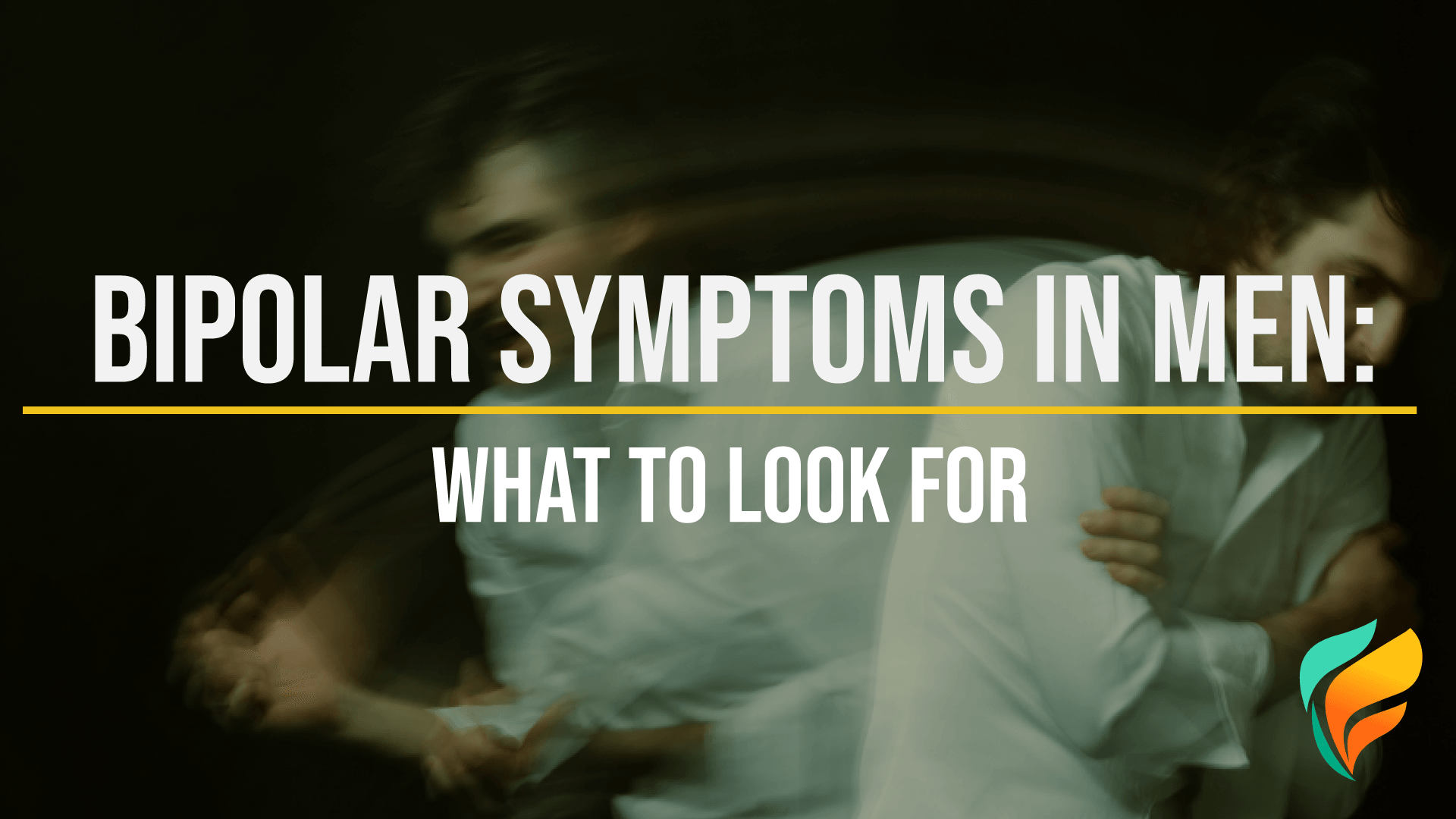Bipolar Symptoms in Men: Is Bipolar Disorder Different for Men and Women?


Do bipolar symptoms in men show up differently? Bipolar disorder is a serious mental condition, but it can be managed with the right help.
Understanding the symptoms of bipolar disorder, such as severe mania and extreme mood swings, in men is crucial for early intervention and effective treatment. Bipolar disorder can significantly impact daily life, affecting mood, energy, and behavior. Recognizing the signs can help you or your loved one seek appropriate help and support.
This article explores the common bipolar symptoms in men and provides an overview of the treatment options available. By gaining insight into this condition, you can take the first step towards managing and overcoming its challenges with the right guidance and care.
Can Bipolar Disorder Affect Men?
Gender does not play a role in mental health disorders. As mentioned above, the National Institute of Mental Health states that bipolar disorder, distinguished by significant changes in energy and mood level to the point that it begins affecting the capability to perform everyday tasks, impacts 2.8% of American adults. When that group is split by gender, more men (2.9%) are impacted than women (2.8%). In both youth and maturity, men are just as susceptible to bipolar disorder as women.
Bipolar disorder can manifest in several types, which include:
Bipolar I
Bipolar II
Cyclothymic disorder
Individuals with bipolar disorders experience severe emotional states, categorized as depressive, hypomanic, or manic. They additionally suffer from episodes when their emotions and mood are balanced. Because the condition has a powerful impact on psychological and emotional states, gender appears to play a factor in how the illness manifests in the individual.
Is Age a Factor in Bipolar Disorder Onset?
Bipolar disorder typically initially appears in people in their mid-20s; however, it can start sooner or manifest later. Adolescent bipolar disorder has a similar gender distribution; there are no noticeable population-level differences. But when it comes to the degree of the symptoms, bipolar disorder in adolescents frequently differs from bipolar disorder in adults.
The disorder's early stages are characterized by more unpredictable behavioral patterns. For instance, a bipolar adolescent will "cycle" between states of enthusiasm and melancholy more quickly than an adult, who can stay in one condition for more than a day. Therefore, age is only necessary for the course of the disorder and not in terms of gender or differences in illness.
Are You Struggling with Mental Health or Addiction?
We Can Help. Call Us Now!
CALL: 877-839-1772
How Does Bipolar Disorder Affect Men?
Men and women experience bipolar disorder in very different ways. There are a few crucial differences that we should be aware of:
Onset: Bipolar disorder can emerge early in men in comparison to women. Women may also experience more intense fluctuations in mood or seasonal disruptions.
Episodes: Men typically have fewer depressed bouts and mixed mania episodes than women. They also cycle at a slower rate than women.
Bipolar II: This kind of bipolar disorder is more prevalent in men than women, resulting in milder bouts of depression.
Comorbidity: Men are less likely than women to have psychological and medical illnesses. Men are more likely to abuse substances in addition to having bipolar disorder.
Signs and Symptoms of Bipolar Disorder in Men
In this section you’ll lean about the bipolar symptoms in men including manic episodes, depressive episodes and mixed episodes:
Manic Episodes
Manic episodes are the “up” period of bipolar disorder.
Increased Energy and Activity Levels
During manic episodes, men may exhibit a sudden and significant increase in energy and activity. This can manifest as an unusual level of productivity, engaging in multiple projects simultaneously, or participating in physical activities more intensely than usual. This heightened energy often leads to less need for sleep without feeling tired.
Unusually Elevated Mood or Irritability
Men experiencing mania often display an abnormally elevated mood. They may feel excessively happy, euphoric, or optimistic, even in inappropriate or challenging situations. Conversely, some men might become easily irritable or agitated, reacting angrily to minor frustrations or perceived slights.
Impulsive or Reckless Behavior
Impulsivity and reckless actions are common during manic episodes. Men might engage in risky behaviors such as excessive spending, unprotected sex, substance abuse, or dangerous driving. These actions are often done without considering the potential consequences, driven by a sense of invincibility or heightened self-confidence.
Depressive Episodes
Depressive episodes are the other half of bipolar disorder’s mood swings.
Persistent Sadness or Hopelessness
During depressive episodes, men may experience deep and persistent feelings of sadness or hopelessness. This emotional state can be overwhelming, affecting their overall outlook on life and making everyday tasks feel insurmountable.
Fatigue and Loss of Interest in Activities
A significant drop in energy levels is typical during depressive episodes. Men might feel constantly tired, regardless of how much rest they get. Additionally, they often lose interest in activities they once enjoyed, including hobbies, socializing, and sexual activities.
Difficulty Concentrating and Making Decisions
Depressive episodes can severely impact cognitive functions. Men may find it challenging to concentrate, remember details, or make decisions. This cognitive fog can affect their performance at work, school, or in personal responsibilities, leading to further frustration and a sense of inadequacy.
Mixed Episodes
It’s also possible for manic and depressive episodes to occur together.
Simultaneous Symptoms of Mania and Depression
Mixed episodes are particularly complex, involving symptoms of both mania and depression occurring simultaneously or in rapid succession. Men might feel agitated and energized while also feeling profoundly sad or hopeless. This combination can be extremely distressing and confusing.
Challenges in Recognizing Mixed States
Recognizing mixed episodes can be challenging due to the contradictory nature of the symptoms. Men might not realize they are experiencing a mixed state, as the symptoms of mania and depression can mask or overshadow each other. This complexity often leads to misdiagnosis or delayed treatment.
Understanding these signs and symptoms is crucial for early detection and intervention. Recognizing the patterns of manic, depressive, and mixed episodes can help men and their loved ones seek appropriate help, ensuring better management and outcomes for bipolar disorder.
Are You Struggling with Mental Health or Addiction?
We Can Help. Call Us Now!
CALL: 877-839-1772
Living with Bipolar Disorder
Bipolar disorder is an illness characterized by extremes. An individual suffering from bipolar disorder might be unaware they are going through the manic phase. They might be surprised by their actions when the experience is done. However, they may think that other individuals are being unpleasant or hurtful at the time. Some patients with bipolar disorder experience more severe and frequent episodes than others.
Because of the severity of the disease, it might be challenging to maintain employment and relationships. Suicide is also at an increased risk. During manic or depressive episodes, people with bipolar disorder may have odd sensations like hearing, smelling, or seeing things that are not present (hallucinations).
They might also hold beliefs that appear unreasonable to others (delusions). They might additionally hold beliefs that appear unreasonable to others (delusions). These symptoms are referred to as a psychotic episode or psychosis.
How Can Men Cope with Bipolar Disorder?
If you see any of the following frequent bipolar symptoms in men, here are some approaches you can take:
First, it's crucial to guarantee that the chat is secret. Finding a safe, neutral location might show someone you value one's privacy. It can also serve as further evidence that he can trust you confidently and easily.
It can be challenging, but try to avoid dynamically presenting the problem.
Start the conversation by emphasizing how much you care about him and are interested in his well-being.
Avoid entering the debate with a long list of actions you deem strange or dubious. As much as you can, try to keep him from becoming irritated. This may assist him in avoiding being hostile.
Tell him you think what you're witnessing might result from a force beyond his control.
Make it clear that you're ready to support him in getting the care he needs and that numerous psychological conditions may be addressed successfully.
Learning how to assist a person with bipolar disorder depends on each.
Are You Struggling with Mental Health or Addiction?
We Can Help. Call Us Now!
CALL: 877-839-1772
Finding Bipolar Disorder Treatment for Men
Although treating someone with bipolar disorder can be beneficial, bipolar disorder in men is typically considered a lifelong mood disorder. Before a treatment plan is in place that is as effective as possible, the road may not be simple, and it may take some time and multiple different efforts.
Getting a bipolar disorder diagnosis is the first step in any of this, so you can then locate the individual you can help. Once a good plan is in place, it will be crucial to maintain consistency in therapy. For some men, this might be challenging because they may be incredibly tempted to quit their medication as soon as they start to feel better. Managing bipolar disorder requires a strong support network.
The National Alliance on Mental Illness states that the therapy for bipolar disorder has an 80% success rate. Below are some treatment and therapy methods used to address bipolar disorder.
Antipsychotics and mood stabilizers are typical and efficient therapy for everyone with bipolar illness. Antidepressants are occasionally used but must be constantly watched because they occasionally trigger manic episodes.
Self-management approaches and self-help methods are also beneficial. Bipolar disorder management includes mindful meditation, yoga, eating a balanced diet, working out, and getting adequate sleep. Education is essential since it can aid in identifying early signs of an episode.
Talk therapy, commonly called psychotherapy, can help people with BPD by using cognitive behavioral therapy (CBT), family-focused therapy, or a mix of the two.
Struggling with Bipolar Disorder? You’re Not Alone
The relentless mood swings of bipolar disorder can make life unbearable. If you’re struggling with bipolar disorder, you know what it’s like. You feel lost, alone, and misunderstood. But you’re not alone. Bipolar disorder can significantly impact one's quality of life, but with the right support and treatment options, it is manageable.
Guided by a trauma-informed approach, The Forge Recovery Center provides expert help for bipolar symptoms and more. Our effective treatment and recovery plans will help you manage your symptoms and safely explore the roots of your issues.
We’re dedicated to helping individuals navigate their mental health challenges and achieve lasting recovery. If you or a loved one is experiencing symptoms of bipolar disorder, reach out to us today. Our compassionate team is here to provide the care and support needed to reclaim your life.
Are You Struggling with Mental Health or Addiction?
We Can Help. Call Us Now!
CALL: 877-839-1772





